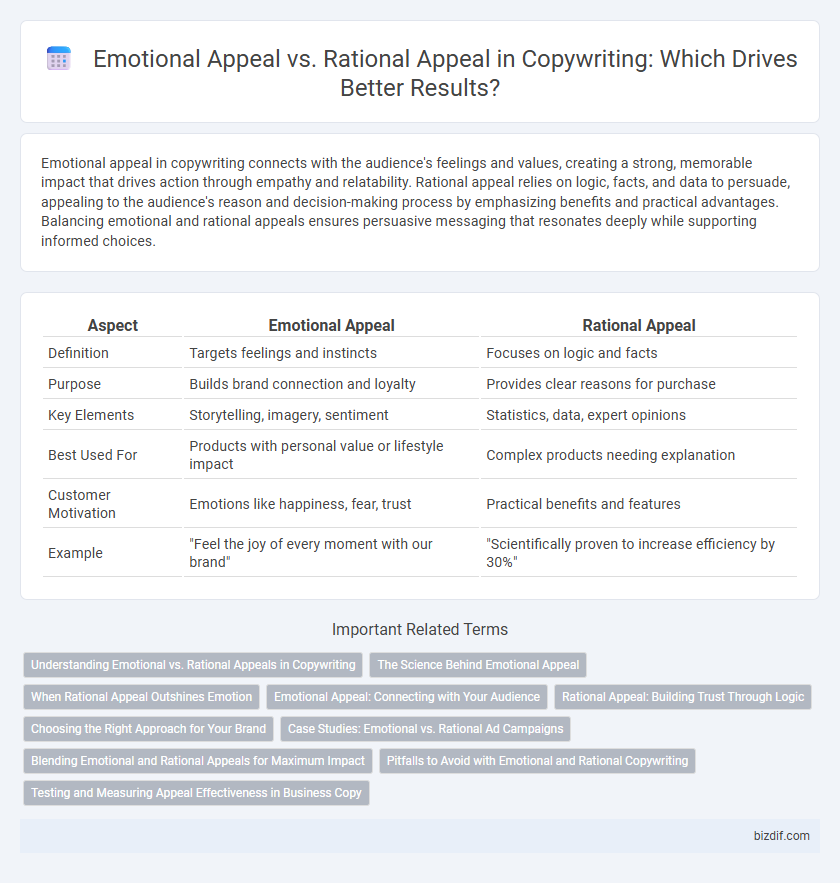Emotional appeal in copywriting connects with the audience's feelings and values, creating a strong, memorable impact that drives action through empathy and relatability. Rational appeal relies on logic, facts, and data to persuade, appealing to the audience's reason and decision-making process by emphasizing benefits and practical advantages. Balancing emotional and rational appeals ensures persuasive messaging that resonates deeply while supporting informed choices.
Table of Comparison
| Aspect | Emotional Appeal | Rational Appeal |
|---|---|---|
| Definition | Targets feelings and instincts | Focuses on logic and facts |
| Purpose | Builds brand connection and loyalty | Provides clear reasons for purchase |
| Key Elements | Storytelling, imagery, sentiment | Statistics, data, expert opinions |
| Best Used For | Products with personal value or lifestyle impact | Complex products needing explanation |
| Customer Motivation | Emotions like happiness, fear, trust | Practical benefits and features |
| Example | "Feel the joy of every moment with our brand" | "Scientifically proven to increase efficiency by 30%" |
Understanding Emotional vs. Rational Appeals in Copywriting
Understanding emotional versus rational appeals in copywriting is essential for crafting persuasive messages that resonate with target audiences. Emotional appeals tap into feelings such as fear, happiness, or nostalgia to drive consumer behavior, while rational appeals rely on logical reasoning, data, and facts to persuade decision-making. Effective copywriters strategically balance these appeals to enhance brand engagement and conversion rates by aligning with customer motivations and thought processes.
The Science Behind Emotional Appeal
Emotional appeal leverages the brain's limbic system, activating feelings that drive consumer decisions faster than logical reasoning. Neuroscientific studies reveal that emotional responses often create stronger memory retention and brand loyalty compared to rational appeals. By tapping into empathy, fear, joy, or trust, copywriters effectively influence purchasing behavior through subconscious mechanisms.
When Rational Appeal Outshines Emotion
Rational appeal outshines emotion in B2B copywriting where decision-makers prioritize data, ROI, and product functionality over feelings. In technical industries like software or manufacturing, detailed specifications, case studies, and cost-benefit analysis effectively persuade logical buyers. When customers face high-investment or risk-averse purchases, clear evidence and factual benefits outweigh emotional triggers for confidence and trust.
Emotional Appeal: Connecting with Your Audience
Emotional appeal in copywriting leverages feelings such as empathy, fear, joy, or nostalgia to create a strong connection with the audience, making messages more memorable and persuasive. By tapping into the audience's core desires and values, emotional appeal fosters trust and loyalty, driving higher engagement and conversion rates. Brands that effectively utilize emotional storytelling often outperform those relying solely on rational appeal, as human decisions are predominantly influenced by emotion over logic.
Rational Appeal: Building Trust Through Logic
Rational appeal in copywriting leverages data, statistics, and factual information to establish credibility and build trust with the audience. By presenting clear benefits, logical arguments, and evidence-based claims, it helps consumers make informed decisions grounded in reason. This approach is particularly effective in B2B marketing, financial services, and sectors where trust is built on transparency and reliability.
Choosing the Right Approach for Your Brand
Emotional appeal in copywriting connects with the audience's feelings, fostering loyalty and brand attachment, while rational appeal relies on facts, statistics, and logical arguments to persuade practical decision-making. Choosing the right approach depends on your brand identity, target audience, and product nature; emotional appeal suits brands aiming for deep connections, whereas rational appeal fits industries like technology or finance where trust and information are paramount. Balancing both appeals can enhance engagement, but understanding your customer's motivations ensures more effective communication and conversion.
Case Studies: Emotional vs. Rational Ad Campaigns
Case studies reveal that emotional appeal-driven ad campaigns, such as Nike's "Just Do It," generate higher brand loyalty and engagement by connecting with audiences on a personal, motivational level. Rational appeal campaigns, exemplified by IBM's focus on product features and data security, demonstrate effectiveness in B2B markets where decision-makers prioritize logic and factual information. Marketers strategically leverage emotional appeal to build lasting consumer relationships, while rational appeal excels in scenarios requiring clear, evidence-based decision-making.
Blending Emotional and Rational Appeals for Maximum Impact
Effective copywriting harnesses the power of blending emotional appeals, which connect with audience values and desires, with rational appeals that provide logical reasons and factual benefits. This strategic combination enhances persuasion by engaging both the heart and mind, increasing trust and motivating action. Brands that integrate storytelling with compelling data often achieve higher conversion rates and stronger customer loyalty.
Pitfalls to Avoid with Emotional and Rational Copywriting
Overreliance on emotional appeal can lead to manipulation perceptions, eroding trust and damaging brand credibility. Ignoring data-driven insights in rational appeal risks producing unconvincing arguments that fail to motivate action or address audience objections. Balancing emotional resonance with factual evidence ensures persuasive copywriting that connects authentically and delivers measurable results.
Testing and Measuring Appeal Effectiveness in Business Copy
Testing and measuring the effectiveness of emotional versus rational appeal in business copy involves A/B testing different message variations to analyze consumer engagement metrics like click-through rates and conversion rates. Utilizing analytics tools to track behavioral data and conducting surveys to gather qualitative feedback helps identify which appeal resonates best with the target audience. Optimizing copy based on data-driven insights ensures improved ROI by aligning marketing messages with customer decision-making processes.
Emotional Appeal vs Rational Appeal Infographic

 bizdif.com
bizdif.com